A History of the County of Surrey: Volume 3. Originally published by Victoria County History, London, 1911.
This free content was digitised by double rekeying. All rights reserved.
'Parishes: Shalford', in A History of the County of Surrey: Volume 3, (London, 1911) pp. 107-111. British History Online https://www.british-history.ac.uk/vch/surrey/vol3/pp107-111 [accessed 19 April 2024]
In this section
SHALFORD
Scaldefor (xi cent.); Scaudeford (xiii cent.); Shaldeford (xiv cent.); Shalforde (xvi cent).
The parish of Shalford lies south-east of Guildford. It is intersected by the River Wey from south to north, and the Tillingbourne running east and west joins the Wey close to the village. It is bounded on the north by St. Mary's and Holy Trinity parishes, Guildford, and by Stoke; on the east by Chilworth; on the south-east by Wonersh; on the south by Bramley; on the south-west by Godalming; on the west by St. Nicholas Guildford. The parish contains about 2,560 acres. It is 6 miles long from north to south, 2 miles broad, generally, with a narrow tongue running out further to the west.
The soil is chiefly the Lower Greensand, with an outcrop of Gault, and also of Wealden Clay at Shalford Park. But like all the parishes on the southern side of the chalk range the northern boundary extends on to the chalk down, where a suburb of Guildford, called Warwick's Bench, is in Shalford parish, not included in Guildford Borough.
Shalford Common is a stretch of open grass extending from near Tangley Manor in Wonersh to the Wey. Trunley Common and Gosden Common are almost touching it to the south-west of the parish, and part of Peasemarsh Common is in Shalford to the west. From near Shalford village towards St. Martha's Hill, the Chantry Woods, so named from part of them having formed the endowment of the Norbrigge Chantry in Trinity Church, Guildford, are a wooded ridge on the highest part of the Greensand. Half the parish is open common or wood.
The old Common Fields, finally inclosed in 1803, lay between Shalford village and Guildford, on the east side of the road. On the west side is Shalford Park. This road intersects the parish, and divides on Shalford Common, leading south to Horsham, east to Dorking.
The parish is also intersected by the Red Hill and Reading Branch of the South Eastern Railway. Shalford Station was opened in 1849. The London Brighton and South Coast and London and South Western Railways intersect the parish, but there are no stations upon them. The canal, made in 1813, connecting the Wey and the Arun, left the former river in Shalford parish. It became unnavigable about 1870, and is now quite abandoned.
There is a brewery at Broadford on the Wey. At Summersbury there is a tannery, which has been established over a century. (fn. 1) Cloth-making was carried on at Shalford in the 17th century. (fn. 2) There are chalk pits and lime kilns on the slope of the downs, in the northern part of the parish.
In 1086 there were three mills at Shalford. (fn. 3) One water-mill only is mentioned in an extent of East Shalford in 1332. (fn. 4) When the manor was divided the lords of each moiety had half the mill. In 1547 Christopher More of Loseley held the mill, which had recently belonged to Robert Wintershull. (fn. 5) This is Pratt's mill now existing on the Tillingbourne. The other two mills seem to have been upon the River Wey, near Unstead, and near the weir above St. Catherine's lock (fn. 6) respectively, being referred to in a lawsuit in 1379 between the inhabitants of Shalford and Robert de Chisenhale, &c. (fn. 7)
A cottage near the old way from St. Catherine's Ferry to St. Martha's Hill, isolated from the village by the old Common Fields, is traditionally called the Pest House. It is usually known now as Cyder House Cottage. In the last house of the parish on the lefthand side of Quarry Hill on the road into Guildford, John Bunyan is said to have held a meeting.
Neolithic implements and a few Roman coins have been found near East Shalford Manor House, (fn. 8) and palaeolithic implements have been found between the Chantry Woods and the chalk down.
Opposite the church is an old house called Dibnersh, the residence of the Misses Morris. It formerly belonged to the Duncombe family (see Albury and Ockley), and was sold to Mr. Robert Austen in 1755.
Bradstone Brook is the seat of Mr. J. H. Renton; it was built in 1791 by Mr. Thomas Gibson. Gosden House, the property of Mr. F. E. Eastwood, is the residence of Mr. S. Christopherson. A considerable number of small gentlemen's houses have been built in the parish, and a large residential suburb of Guildford is springing up about Pewley Hill in Shalford.
There is a Wesleyan chapel on Shalford Common, originally established in 1843. A new building was erected in 1895. Near the eastern border of the parish is a small iron church where services are held, and another on the borders of Peasemarsh.
The cemetery was opened in 1886. The Village Hall, presented by Mr. Edward Ellis of Summersbury in 1886, is near the station. It contains a refreshment room, meeting room, and reading room.
The school was built as a Church of England school in 1855. In 1881 it was transferred to a school board, and the buildings were enlarged in 1882.
Shalford is one of the prettiest and most charmingly situated villages in Surrey, lying as it does in the midst of water meadows, with tall poplars and other fine trees, between the River Wey and its tributary the Tillingbourne. The village consists of a winding street of picturesque old cottages, with a few others straggling up side lanes and down to the water. The Seahorse Inn is a pleasant old-world hostelry with square-leaded panes to the windows. Many of the cottages appear to have been smartened up as to their fronts in the beginning of the 19th century, but the backs and interiors show them to be really old. A short lane leads down to the little watermill, tile-hung almost to the ground, and having a large projecting upper story carried on wooden pillars.
It is probable that its proximity to Guild ford made Shalford a favourite country retreat, and that this accounts for there being several houses of some pretension. Among others, near to the mill, is one which as it does not face the road is easily overlooked. It has a gable of stone with very ornamental brick dressings, and this and the other gables, which are curved and pedimental, bear a close resemblance to the early examples of brickwork in Godalming, Guildford, Farnham, &c., and both inside and out it has many points in common with the old manorhouse of Slyfield, in Great Bookham parish.
This house, called Old House, but formerly Mill House, has some good mullioned windows with lead glazing, in square and diamond panes, and a good door-head. It is panelled in nearly all the rooms, and there is a particularly fine staircase, very like that at Slyfield, with rusticated newels, and instead of balusters pierced arabesque scroll-work cut out of the solid.
As a relic of the past, the stocks and whipping-post, shaded by the yew tree under the churchyard wall, are of interest.
MANORS
The manor of SHALFORD or EAST SHALFORD (fn. 9) was held jointly by two brothers in the time of Edward the Confessor. (fn. 10) In 1087 it was held by Robert (possibly de Wateville) of Richard de Tonbridge. (fn. 11) The latter was the ancestor of the de Clares, and the manor continued to be held of the honour of Clare. (fn. 12) It is probable that the de Watevilles were the under-tenants until the reign of Henry II, when Robert de Wateville is said to have sold the manor to Robert de Dunstanville. (fn. 13) Walter de Dunstanville gave the manor with his sister Alice in marriage, but repossessed himself of it, whereupon Gilbert Bassett, son of Alice, obtained a confirmation of his rights from King John. (fn. 14) Richard de Camvill and his wife Eustacea (daughter and heiress of Gilbert Bassett) are said to have had the custody of Shalford during the minority of the heir of Walter de Dunstanville. (fn. 15) Richard's daughter Idonea married William Longespée son of the Earl of Salisbury, (fn. 16) and with him seems to have retained the manor (fn. 17) in spite of continued suits by a certain Sibyl. (fn. 18) Finally, William Longespée granted the manor to John son of Geoffrey, Earl of Essex. (fn. 19) His son John died seised of it, leaving a brother and heir Richard, (fn. 20) whose widow Emma, afterwards wife of Robert de Montalt, (fn. 21) held it in dower. (fn. 22) She conveyed her right in it to Hugh le Despenser the younger, to whom Idonea Crumbwell, one of the heirs of Isabel sister and co-heir of Richard son of John, (fn. 23) also released her claim in that moiety of the manor which should have descended to her at the death of Emma de Montalt, (fn. 24) this conveyance being forced on her against her will. (fn. 25) Robert, Lord Clifford, the other coheir of Isabel, (fn. 26) made no quitclaim to the Despensers. Therefore when, at the forfeiture of the latter's estates, Shalford was taken into the king's hands, (fn. 27) this moiety remained with Robert Clifford and became the manor of Shalford Clifford. (fn. 28)

Clare. Or three cheverons gules.
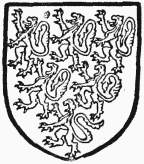
Longespée. Azure six lioncels or.
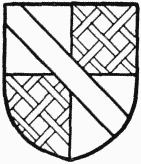
Despenser. Argent quartered with gules fretty or with a bend sable over all.
SHALFORD CLIFFORD
SHALFORD CLIFFORD was settled by Robert, Lord Clifford, on his youngest son Thomas for life. (fn. 29) In 1373 Sir Roger Clifford, kt., second son, but ultimately heir, of Robert, conveyed the reversion at his brother's death to his own son Thomas and his wife Elizabeth, (fn. 30) who survived her husband. (fn. 31) Their grandson and heir, Thomas, Lord Clifford, was killed at St. Albans in 1455, leaving a son and heir John, Lord Clifford, who was killed at Ferrybridge and attainted in 1461. (fn. 32) His lands were granted to an usher of Edward IV, Nicholas Gaynesford, (fn. 33) who was himself attainted at the accession of Richard III. (fn. 34) The manor was granted by that king to Sir John Neville. (fn. 35) On the accession of Henry VII it was restored to Henry, Lord Clifford, 'the shepherd lord,' with the other possessions of his father, John, Lord Clifford. (fn. 36) His grandson Henry, second Earl of Cumberland, sold Shalford to Sir Anthony Browne in January 1543–4. (fn. 37) Sir Anthony had inherited Shalford Bradestan, the other moiety of the original manor. Thus the two moieties were reunited and descended to Sir Anthony's son, who was created Viscount Montagu in 1554. (fn. 38) Francis, third viscount, sold the manor to Sir John Nicholas in 1677. (fn. 39) In 1733 the executors of Edward Nicholas, his son, who died in 1726, sold the manor to Thomas, Lord Onslow, (fn. 40) in whose family it has since remained, the present owner being William Hillier, Earl of Onslow.
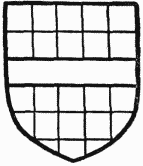
Clifford, Earl of Cumberland. Checky or and azure a fesse gules.
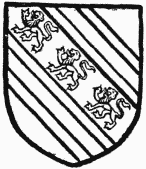
Browne, Viscount Montagu. Sable three lions passant bendways between double cotises argent.
When the manor was taken into the king's hands in 1333 (vide supra) the custody of SHALFORD BRADESTAN, the second moiety of Shalford, was granted successively to William Hatton, Henry Hussey, and Thomas de Ponings. (fn. 41) The last held it for life. At his death it was granted in tail to Sir Thomas de Bradestan, from whom it obtained the name of Shalford Bradestan. He was succeeded in 1360 by his grandson and heir Thomas, (fn. 42) who died a minor in 1374, leaving an infant daughter Elizabeth, (fn. 43) who married Walter de la Pole. (fn. 44) He died seised of Shalford Bradestan in right of his wife in 1434. (fn. 45) Their grandson Sir Edmund Ingaldesthorp, kt., inherited the manor. (fn. 46) At his death in 1456 his widow Joan held the manor in dower, her husband's heirs being the children of his daughter Isabel, Marchioness Montagu. One of these, Lucy Fitz William, inherited Shalford Bradestan at Joan's death in 1494, (fn. 47) and bequeathed it to her son William Fitz William and his wife Mabel (fn. 48) for life, with reversion to her son Sir Anthony Browne, who had purchased the other part of Shalford Clifford (vide supra), so that the whole was reunited and descended as above. The demesne of the whole manor called East Shalford Manor was purchased in 1779 by Robert Austen, and is the property of Colonel Godwin Austen, his descendant.
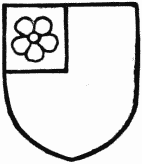
Bradestan. Argent a quarter gules with a rose or therein.
There was a custom that the lord of Shalford might tally his bond-tenants 100s. yearly. (fn. 49) In the 13th century John son of Geoffrey, lord of Shiere, unjustly appropriated view of frankpledge to himself there. (fn. 50) The right of free warren was appurtenant to the manor. (fn. 51) In the 14th century the lords of Shalford Clifford and Bradestan paid Romscot to the vicar of Shalford. (fn. 52)
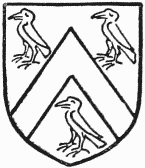
Austen of Shalford. Azure a cheveron argent between three choughs or.
The early history of the reputed manor of UNSTEAD (Townhampstead, Ownstead, or Unsted, xvi cent.) is obscure. In 1256–7 William de Wintershull acquired land in Dunsfold, Hascombe, Bramley, and 'Tunchamstede,' from Geoffrey de Braboeuf. (fn. 53) Late in the 13th century William son of Eustace of East Catteshull granted lands in East Catteshull in Bramley to John son of Ralph de Tonhamstede, in exchange for land called Pinnokesland. (fn. 54)
In 1385 William Webbe complained at the Godalming Hundred Court of trespass upon his land at 'Tunhamstede.' (fn. 55) Later in the 15th century Henry Stoughton was seised of Unstead, and his son Thomas was in possession in 1459–90.
Thomas had a son Gilbert, and in 1517 Gilbert Stoughton died seised of Unstead, held of the manor of Selhurst (or Wintershull), his son Laurence being his heir. (fn. 56)
In 1547 Laurence Stoughton conveyed it to John Parvish, jun., in exchange for lands in Stoke. (fn. 57) John Parvish of Unstead was buried in 1583. (fn. 58) His nephew Thomas Parvish sold the manor in 1588 to his cousin Henry Parvish, citizen and haberdasher of London, who died 4 August 1593, having settled his estate on his sons and their heirs female. (fn. 59)
The capital messuage was bought in 1608 by Sir George More of Loseley from Gabriel Parvish, son of Henry, (fn. 60) and he in 1609 conveyed to George Austen, (fn. 61) who died seised of it in 1621, and was succeeded by his son John. (fn. 62) He sold it in 1626 to the trustees of Henry Smith's Charity in Godalming, (fn. 63) and they conveyed it to the Corporation of Godalming for a sewage farm in 1894.
The reputed manor was apparently divided among the Parvish family, and Unstead Manor Farm was a possession of the Onslow family during the 17th and 18th centuries. (fn. 64) It was exchanged by George, first Earl of Onslow, with John Sparkes, from whom it eventually came to Captain Albemarle Bertie, (fn. 65) who sold it in 1800 to Captain William Pierrepont. (fn. 66) He conveyed it to Mr. H. Trowers. It is now part of the property of Mr. L. Phillips. The farm is on the right-hand side of the road leading from the Portsmouth road to Bramley, formerly called Trowers.
SHALFORD RECTORY MANOR.
King John granted to John of Guildford, parson of Shalford, a yearly fair to be held in the church and churchyard on the vigil, day, and morrow of the Assumption. The parson took no toll, but claimed the stakes fixed in the cemetery and his fee outside, and held pleas for merchants staying in his fee. When the fair grew so large that it extended into Bramley Manor, the lords of Bramley took the stakes of merchants in their fee, and also held courts for them. (fn. 67) In 1304–5 Edward I granted two messuages and land with the services of free tenants in Shalford and the advowson of Shalford to the Hospital of St. Mary Without Bishopsgate. (fn. 68) The prior evidently leased the rectory from time to time. Roger Elliot, who had obtained such a lease in 1475–6, complained that the prior forced him, being 'a stranger not acqueynted in the Cite of London and ferr from his frendes and wife,' to pay his rent a second time. (fn. 69) After the Dissolution Queen Elizabeth granted the rectory of Shalford with court leet, view of frankpledge, law-days, and assize of bread and ale, to her secretary John Wolley. (fn. 70) He sold it in 1590 to his brother-in-law, George More, (fn. 71) afterwards Sir George More, from whom it was purchased in 1599 by John Austen, (fn. 72) who built Shalford House on a place called the Timber Yard, on the rectory manor, 1608–10. (fn. 73) The rectory still remains in the possession of his descendants. George Austen died at Shalford in 1621, leaving a son John, who inherited the rectory manor. (fn. 74) Robert Austen and his mother Elizabeth were in possession in 1714, at which date Robert Austen was living in the 'Parsonage House.' (fn. 75) The present owner is Lieut.-Colonel Henry Haversham Godwin Austen, of Nore, Bramley.
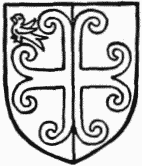
Hospital of St. Mary without Bishopsgate. Party argent and sable a mill-rind cross counter-colured with a martlet gules in the quarter.
The house of Shalford Park is said to be close to the site of the old rectory manor-house, but the actual site was called the Timber Yard. In 1609 Sir George More conveyed the manor of Unstead to George Austen, subject to redemption on the payment of £800 in 1611, in the tenement of the said Austen, 'now in building upon a parcel of land called the Tymber Yarde parcel of the parsonage of Shulforde in the Parish of Shulforde.' (fn. 76) Colonel Godwin Austen, lord of the manor, has the building accounts from 1608 to 1610, showing that it was built in stone and brick. The house was much altered, and a top story added by Sir Henry Edmund Austen, who succeeded, as a minor, in 1797. The front part of the house, now quite modernized in appearance, is internally of the original date; but the carved wooden mantelpiece in the room to the left of the front door, bearing the date 1631, was brought from elsewhere. The oak room, on the right hand of the front door, has good panelling, mantelpiece, and ceiling of the later 17th century. The carved mantelpiece bears the curious motto Heyme incalesco, aestate refrigero—which, as Mr. Ralph Nevill remarks, is 'a proof that our ancestors were sufficiently alive to the advantages of open fireplaces.' The library was originally the kitchen. The mantelpiece bears the date 1681, and the iron fireback has the royal arms of Charles II. The diningroom was built by the late owner in 1875. The mantelpiece, chalk, with the date 1609, was brought from Tyting Farm. (fn. 77) There was a fine gallery of pictures, some of which are still in the house, which is at present let as a private hotel.
CHURCH
The church of ST. MARY is the third that has stood on the present site since 1789, in which year the mediaeval building, possibly retaining parts of that mentioned in Domesday, was rebuilt. A view of the church from the south-east, as it appeared in 1780, shows a picturesque irregular building of cruciform plan, having a short and rather high nave with a south porch, a central tower, and shingled spire, apparently of 12th or 13th-century date, beneath which is a transept, or rather two transeptal chapels, conjoined, and having a double-gabled roof, with 15th-century windows, and a longish chancel with a priest's door and a three-light east window of 15th-century date.
In 1789 the church was rebuilt in local stone rubble with brick dressings—a very ugly, heavy structure—having a squat tower with domed roof of copper, surmounted by a cupola. There was no chancel, only an alcove or shallow apse, projecting from the east end of the nave. Cracklow's view of 1824 preserves the memory of this building, which, in 1847, was in its turn entirely demolished to make way for the present structure, an ambitious but unsatisfactory example of the 13th-century style. This consists of nave, aisles, transepts, and chancel, with south porch and tower with shingled spire at the north-west angle. The whole building is excessively high in proportion to its length, and the detail is starved and bad.
There are no monuments of any interest except some tablets to the Austens and to the local family of the Eliots, of 17th and 18th-century dates.
The old font is at present turned upside down, and placed as a mounting block outside the vicarage. It may shortly be restored to the church. There are two pieces of old glass, preserved from the original church, showing the arms of Canterbury and Winchester.
The church plate is of the 18th century, and of no great interest.
There are five bells of 1789, and one of 1866, all
by the firm of Warner. When the six were complete
they each bore a part of the verse:—
'Thy glory Lord we will resound | to all the
listening nations round | and with our tongues | our
voices raise | to Thee O God | in songs of praise.'
Before 1789, four, dated 1613, by Robert Eldridge,
bore the verse:—
'Lord plead my cause against my foes | Confound
their force and might | Fight on my part against my
foes | That seek with me to fight.'
In the Edwardian inventory eight bells and a 'sawnce' bell are mentioned.
The registers begin in 1564, but there are no marriages till 1581. There is a gap between 1651 and 1653, and the marriages are lost from 1754 to 1782.
ADVOWSON
The church is mentioned in the Domesday Survey. (fn. 78) In 1224 it was stated that the king's ancestors had always presented to Shalford and its chapelries, but that Ralph de Fay, lord of Shalford, last presented in the time of the war. (fn. 79)
It was granted with the rectory to the Hospital of St. Mary Without Bishopsgate in 1304–5. After the Dissolution it passed into the possession of various persons. (fn. 80) Towards the close of the 17th century the Crown presented and continues to do so. (fn. 81)
There seems to have been a chapel attached to the manor of Shalford Bradestan, for in 1374–5 Ellen, mother of Sir Robert Bradestan, held in dower the chancel of the chapel there. (fn. 82)
CHARITIES
Smith's Charity is distributed as in other Surrey parishes. Many small rents and payments were due to the church. (fn. 83)
In 1715 Dr. Shortrudge, Sir Francis Vincent, and others settled the residue of the profits on estates in Hertfordshire on the vicars of Shalford, Great Bookham, Effingham, and Letherhead, on condition of their reading prayers in church on Wednesdays and Fridays, and preaching appropriate sermons on 30 January and on Good Friday. (See Great Bookham.)
